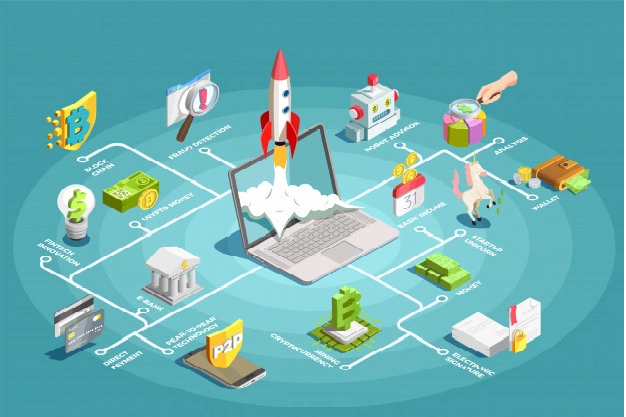
Whether it is the healthcare industry, fashion, business, or our daily lives, technology has touched all grounds so as financial services too. Technological intervention in the financial sector makes it the Fintech industry. In the past 10 Years, fintech trends & opportunities have grown rapidly. After the 2008 financial crisis in the US, it was difficult for the world to trust banks as everyone was devastated after listening to the situation. It led people to avoid traditional ways of banking. Here, fintech came into the picture. An industry that offers financial and banking support with the advancement of technology to provide transparency, convenience, and a lot more.
Although, banking services (government & private both) have evolved themselves to adopt fintech. However, that is not the limit the fintech industry has chosen for itself. It is there in administration work, data management, customer experience and many more sectors.
Therefore, now we have small institutions and businesses providing fintech services. Let’s have a look at what the fintech industry has for the world?
FinTech Industry Trends
1) Cybersecurity
The biggest concern of the banking sector is the security of their customer details. Since technology developers are constantly trying innovative ways to secure customer data yet hackers are playing their cards too, all the time. For instance, in the Equifax data breach case, hackers used data that was not secured as the company did not update their struts on time that allowed breaching data.
To eradicate such situations, fintech companies and startups are trying to find new ways. A few of those ways are,
Multi-cloud data storage
- Blockchain
- Secure Access Service Edge (SASE)
- Decentralisation

2) Blockchain
Since we used the term “Blockchain” above, it is imperative to explain how is this technology helping the fintech industry.
Blockchain is the decentralised ledger technology that enables bankers and other financial companies to store their customer data in multiple locations. It has helped boost global transactions with less processing fees. It has been observed by PwC that, blockchain is potentially a game-changer of financial services in the coming future with an estimate benefit of $1.76 trillion.
3) Internet Of Things (IoT) And Sensors
The sensors that are used in the Fintech industry are to identify the user behaviour and preferences to give better service experiences to the customers. Companies can use this data to offer:
- Better customer service
- Risk management and decision making
- Enhance security
These sensors are being used in ATMs to check the usability of the ATMs. In the micro-payment cards (debit and credit cards) to enable convenient payments without entering the pin, up to a certain limit.
These sensors are often called the revolutionary change in the financial sector.
4) Digital Banking
How many of you still go to the bank for daily banking needs? Even the bank says now, “Get the bank at home” with their digital banking services.
There is almost everything which can be done while sitting at home. For instance, account opening, bank transfers, bank statements, loan applications, investments, the list is never-ending. Initially, the public had a fear of losing money but, digital banking enabled transparency that they were looking to trust banks and other financial services.
Not just this, there are multiple neobanks (online-operating banks) in the industry built with the mobile-friendly concept. These banks do not have a physical presence, all they have is an app and the backend technology support through which they are catering to the customers with all their banking solutions.

5) Voice-Enabled Payments
We already have exposure to voice-enabled usage of smartphones to smart home devices such as Google Assistant, Siri, and Alexa. Similarly, voice-enabled payments will use voice recognition technology, to make it convenient for users for making payments with a verbal command only. The development of this technology will ensure aid to visually impaired people enabling them to access cashless transactions.
6) Virtual Cards
This concept was designed as an eco-friendly transition in the fintech industry. Since these are virtual cards, you will not get a physical plastic card. All you will have is a debit/credit card number, CVV and the expiry date.
Moreover, you will not be charged extra money for the issuance of a banking card and a duplicate card (in case of theft). Also, most of these virtual cards come with loyalty programs and can be used for both flat and crypto transactions.
7) Augmented Reality (AR) / Virtual Reality (VR)
The intervention of virtual reality in the fintech industry can be seen in the stock market. The way investors are investing and keeping a real-time track of the trade market on their mobile screens is the biggest example of how VR is helping the fintech industry.
AR and VR in fintech is a booming technology, as per Goldsman Sachs. They estimate that AR and VR in fintech will become an $80+ billion industry by 2025. Also, big corporations like Meta (formerly Facebook) show their interest in VR. Meta invested $10 billion in 2021 into VR to build ‘MetaVerse’.

Conclusion
These fintech trends and opportunities may help you choose the career path or convince you to use the fintech industry for better customer experiences. The fintech industry has come a long way but, revolutions are yet to be made, developments will take place, and the fintech companies & startups will offer more modernised services in the future.
